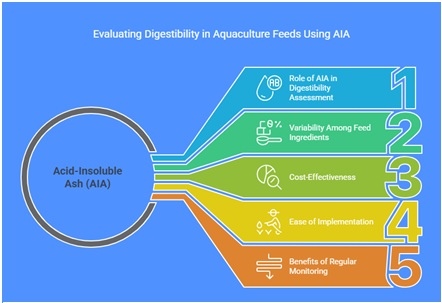POTENTIAL OF ACID-INSOLUBLE ASH (AIA) FOR ASSESSING THE DIGESTIBILITY OF AQUACULLTURE FEEDS
This study examines acid-insoluble ash (AIA) as a natural digestibility marker in aquaculture feeds, offering a cost-effective alternative to external markers. It analyzed AIA content in 18 commercial feeds and 27 ingredients from various sources. Results showed significant variation across ingredient categories, with marine-based and rendered animal meals containing the highest AIA levels, while vegetable meals had the lowest. Shrimp and crab meals showed particularly high AIA content due to their mineral-rich exoskeletons. Higher quality processed meals contained less AIA than regular versions. The study established a limit of quantification for the AIA protocol. Findings demonstrate that commercial diets contain quantifiable AIA, making it viable for digestibility studies and rapid feed quality assessment.
Introduction
Feed quality depends on ingredient sources and manufacturing methods, but in-vivo digestibility studies are costly and logistically challenging when using traditional external markers like chromic oxide and yttrium oxide.
AIA offers a cost-effective alternative as it naturally occurs in feed ingredients. Multiple studies comparing AIA with external markers have found comparable digestibility results across various aquatic species including rainbow trout, tilapia, hybrid striped bass, Atlantic salmon, and abalone – demonstrating AIA’s effectiveness when properly quantified.
The key advantage of AIA is eliminating the need to artificially mark commercial diets. This study analyzes AIA content in 27 commercial feeds and 18 ingredients to determine which contain quantifiable levels. This knowledge would allow feed manufacturers and farm managers to assess feed quality rapidly and cost-effectively, supporting better production decisions.
Acid insoluble ash (AIA)
Acid-insoluble ash (AIA) consists primarily of silicate, a naturally occurring indigestible mineral in feed ingredients that remains insoluble during acid digestion and enzymatic hydrolysis. To function as an effective digestibility marker, compounds must be indigestible, non-toxic, non-interfering, inert, homogeneous in diet and feces, and accurately reflect digesta flow. AIA meets these requirements and has demonstrated effectiveness across diverse species including mammals, poultry, shrimp, and fish. Its proven efficacy makes it valuable for evaluating commercial feed digestibility.
AIA in Aquaculture Research
Studies comparing acid-insoluble ash (AIA) with external markers like chromic oxide (CO) and yttrium oxide (YO) have shown mixed results. In rainbow trout, Atlantic salmon, tilapia, and South African abalone, AIA has demonstrated comparable effectiveness to external markers. For example, Witkowski et al. (2019) found AIA viable in commercial-scale salmon production, while studies with tilapia showed AIA supplemented with Celite aligned closely with CO results. In striped bass, 1% celite and 0.5% CO showed no significant differences in apparent digestibility coefficients (ADC).
However, some research indicates limitations. Studies by Tacon and Rodrigues (1984) and Morales et al. (1999) found AIA unsuitable for rainbow trout, yielding erratic and reduced nutrient ADC. Similarly, Li et al. (2008) determined AIA wasn’t promising for red drum. These varied outcomes suggest that feed ingredients, animal species, fecal collection methods, and AIA quantification processes all influence nutrient ADC calculations.
This current research evaluates AIA’s broader applicability by analyzing its presence in commercial aquaculture ingredients and diets, establishing analytical baselines for its use as a marker. The goal is to provide the industry with a practical tool for assessing digestibility of commercial feeds, demonstrating that such diets contain quantifiable amounts of AIA. This approach addresses practical challenges in aquaculture nutrition studies and establishes AIA as a standardized endogenous marker for more effective digestibility assessments.
Acid-insoluble ash in commercial feed ingredients
The study analyzed AIA content in 27 commercial ingredients using a standardized method. Vegetable-based ingredients had minimal AIA due to low mineral content. Among animal proteins, terrestrial meals with high bone content (PFGM, AMBM, PM) showed elevated AIA levels, while high-quality processed terrestrial meals had reduced AIA due to processing methods that decrease ash content. Marine ingredients varied significantly – shrimp meal and crab meal contained high AIA levels from mineral-rich exoskeletons, while other marine meals showed variable profiles based on feeding habits and processing methods. Sardine meals exhibited inconsistent nutritional profiles attributed to seasonal and environmental factors. The research demonstrates that AIA content depends not only on ingredient type (vegetable, land animal, or marine) but also on geographical origin and industrial processing methods employed in production, all of which affect final AIA concentration.
Acid-insoluble ash in commercial feeds
This study analyzed AIA content across 18 commercial aquaculture diets for various species, revealing no consistent patterns among diet categories due to substantial ingredient composition variations. Diets produced in different countries use ingredients with diverse origins, causing significant variations in nutritional profiles. Even identical ingredient types (like soybean meal) can exhibit considerable differences in protein, amino acids, fiber, minerals, and digestibility based on country of origin. High AIA levels likely indicate formulation with regular quality render meals, shrimp meal, or certain forage fish meals, while low AIA levels suggest vegetable meals, high-quality render meals, or specific marine ingredients. These findings emphasize the critical importance of considering ingredient origin and quality during diet formulation to ensure optimal nutritional outcomes.
Conclusion
Acid-Insoluble Ash (AIA) as a reliable endogenous digestibility marker for aquaculture, with significant variations across different ingredients – marine and rendered animal meals showing highest concentrations. The AIA method is simple, cost-effective, and easily implementable in aquaculture operations, allowing farms and feed manufacturers to routinely monitor diet digestibility. This approach eliminates the logistical challenges and expenses of externally marking experimental diets, establishing AIA as a practical alternative for commercial aquaculture digestibility assessments.
Source: Camperio, J., Suarez, J. A., Glencross, B., & Benetti, D. D. (2025). Quantification of endogenous marker acid-insoluble ash in commercial aquaculture ingredients and feeds. Journal of the World Aquaculture Society, 56(2), e70015. https://doi.org/10.1111/jwas.70015

